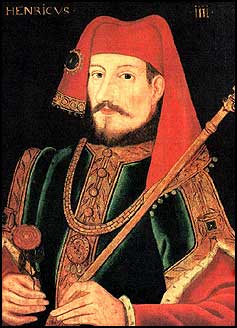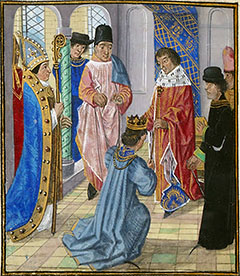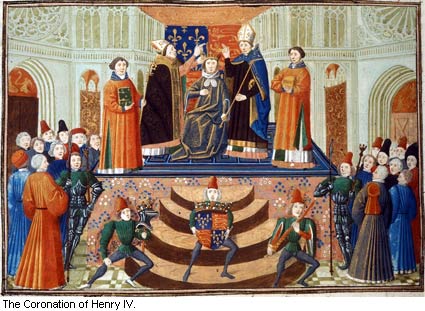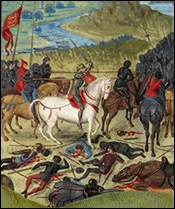|
|
|



HENRY IV, King of England, son of John of Gaunt, by Blanche, daughter of Henry, Duke of Lancaster, was born on the 3rd of April 1367, at Bolingbroke in Lincolnshire.
As early as 1377 he is styled Earl of Derby, and in 1380 he married Mary de Bohun (d.1394), one of the co-heiresses of the last Earl of Hereford. In 1387 he supported his uncle Thomas, Duke of Gloucester, in his armed opposition to Richard II and his favourites. Afterwards, probably through his father's influence, he changed sides. He was already distinguished for his knightly prowess, and for some years devoted himself to adventure. He thought of going on the crusade to Barbary; but instead, in July 1390, went to serve with the Teutonic knights in Lithuania.

"The Challenge of Derby and Mowbray." |
He came home in the following spring, but next year went again to Prussia, whence he journeyed by way of Venice to Cyprus and Jerusalem. After his return to England he sided with his father and the king against Gloucester, and in 1397 was made Duke of Hereford. In January 1398 he quarrelled with the Duke of Norfolk, who charged him with treason. The dispute was to have been decided in the lists at Coventry in September; but at the last moment Richard intervened and banished them both. When John of Gaunt died in February 1399 Richard, contrary to his promise, confiscated the estates of Lancaster. Henry then felt himself free, and made friends with the exiled Arundels.
 Early in July, whilst Richard was absent in Ireland, he landed
at Ravenspur in Yorkshire. He was at once joined by the Percies; and Richard, abandoned by his friends, surrendered at Flint on the 19th of August.
In the parliament, which assembled on the 30th of September, Richard was forced to abdicate. Henry then made his claim as coming by right line of blood from King Henry III, and through his right
to recover the realm which was in point to be undone for default of governance and good law. Parliament formally accepted him, and thus Henry became king, "not so much by title of blood as by
popular election" (Capgrave). Early in July, whilst Richard was absent in Ireland, he landed
at Ravenspur in Yorkshire. He was at once joined by the Percies; and Richard, abandoned by his friends, surrendered at Flint on the 19th of August.
In the parliament, which assembled on the 30th of September, Richard was forced to abdicate. Henry then made his claim as coming by right line of blood from King Henry III, and through his right
to recover the realm which was in point to be undone for default of governance and good law. Parliament formally accepted him, and thus Henry became king, "not so much by title of blood as by
popular election" (Capgrave).

The new dynasty had consequently a constitutional basis. With this Henry's own political sympathies well accorded. But though the revolution of 1399 was popular in form, its success was
due to an oligarchical faction. From the start Henry was embarrassed by the power and pretensions of the Percies. Nor was his hereditary title so good as that of the Mortimers. To domestic
troubles was added the complication of disputes with Scotland and France. The first danger came from the friends of Richard, who plotted prematurely, and were crushed in January 1400.
During the summer of 1400 Henry made a not over-successful expedition to Scotland. The French court would not accept his overtures, and it was only in the summer of 1401 that a truce was
patched up by the restoration of Richard's child-queen, Isabella of Valois.
 Meantime a more serious trouble had arisen through the outbreak of the Welsh revolt under Owen Glendower. In 1400 and again in each of the two following autumns Henry invaded Wales in vain. The success of the Percies over the Scots at Homildon Hill (Sept. 1402) was no advantage. Henry Percy (Hotspur) and his father, the Earl of Northumberland, thought their services ill-requited, and finally made common cause with the partisans of Mortimer and the Welsh. The plot was frustrated by Hotspur's defeat at Shrewsbury (21st of July 1403); and Northumberland for the time submitted. Henry had, however, no one on whom he could rely outside his own family, except Archbishop Arundel. The Welsh were unsubdued; the French were plundering the southern coast; Northumberland was fomenting trouble in the north.
Meantime a more serious trouble had arisen through the outbreak of the Welsh revolt under Owen Glendower. In 1400 and again in each of the two following autumns Henry invaded Wales in vain. The success of the Percies over the Scots at Homildon Hill (Sept. 1402) was no advantage. Henry Percy (Hotspur) and his father, the Earl of Northumberland, thought their services ill-requited, and finally made common cause with the partisans of Mortimer and the Welsh. The plot was frustrated by Hotspur's defeat at Shrewsbury (21st of July 1403); and Northumberland for the time submitted. Henry had, however, no one on whom he could rely outside his own family, except Archbishop Arundel. The Welsh were unsubdued; the French were plundering the southern coast; Northumberland was fomenting trouble in the north.
The crisis came in 1405. A plot to carry off the young Mortimers was defeated; but Mowbray, the Earl Marshal, who had been privy to it, raised a rebellion in the north supported by Archbishop Scrope of York. Mowbray and Scrope were taken and beheaded; Northumberland escaped into Scotland. For the execution of the archbishop Henry was personally responsible, and he could never free himself from its odium. Popular belief regarded his subsequent illness as a judgment for his impiety. Apart from ill-health and unpopularity Henry had succeeded — relations with Scotland were secured by the capture of James, the heir to the crown; Northumberland was at last crushed at Bramham Moor (Feb. 1408); and a little later the Welsh revolt was mastered.
Henry, stricken with sore disease, was unable to reap the advantage. His necessities had all along enabled the Commons to extort concessions in parliament, until in 1406 he was forced to nominate a council and govern by its advice. However, with Archbishop Arundel as his chancellor, Henry still controlled the government. But in January 1410 Arundel had to give way to the king's half-brother, Thomas Beaufort. Beaufort and his brother Henry, Bishop of Winchester, were opposed to Arundel and supported by the Prince of Wales [later Henry V]. For two years the real government rested with the prince and the council.
Under the prince's influence the English intervened in France in 1411 on the side of Burgundy. In this, and in some matters of home politics, the king disagreed with his ministers. There is good reason to suppose that the Beauforts had gone so far as to contemplate a forced abdication on the score of the king's ill-health. However, in November 1411 Henry showed that he was still capable of vigorous action by discharging the prince and his supporters. Arundel again became chancellor, and the king's second son, Thomas, took his brother's place. The change was further marked by the sending of an expedition to France in support of Orleans. But Henry's health was failing steadily. On the 20th of March 1413, whilst praying in Westminster Abbey he was seized with a fainting fit, and died that same evening in the Jerusalem Chamber. At the time he was believed to have been a leper, but as it would appear without sufficient reason.
As a young man Henry had been chivalrous and adventurous, and in politics anxious for good government and justice. As king the loss and failure of friends made him cautious, suspicious and cruel. The persecution of the Lollards, which began with the burning statute of 1401, may be accounted for by Henry's own orthodoxy, or by the influence of Archbishop Arundel, his one faithful friend. But that political Lollardry was strong is shown by the proposal in the parliament of 1410 for a wholesale confiscation of ecclesiastical property. Henry's faults may be excused by his difficulties. Throughout he was practical and steadfast, and he deserved credit for maintaining his principles as a constitutional ruler. So after all his troubles he founded his dynasty firmly, and passed on the crown to his son with a better title. He is buried under a fine tomb at Canterbury.
By Mary Bohun Henry had four sons: his successor Henry V, Thomas, Duke of Clarence, John, Duke of Bedford, and Humphrey, Duke of Gloucester; and two daughters, Blanche, who married Louis III, elector palatine of the Rhine, and Philippa, who married Eric XIII, King of Sweden. Henry's second wife was Joan, or Joanna, (c.1370-1437), daughter of Charles the Bad, King of Navarre, and widow of John IV or V, Duke of Brittany, who survived until July 1437. By her he had no children.
(Charles L. Kingsford)
Excerpted from:
Encyclopedia Britannica, 11th Ed. Vol XIII.
Cambridge: Cambridge University Press, 1910. 293.
Other Local Resources:
Books for further study:
Bevan, Bryan. Henry IV.
Palgrave Macmillan, 2002.
Biggs, Douglas. Three Armies in Britain: The Irish Campaign of Richard II
and the Usurpation of Henry IV, 1397-1399.
Brill Academic Publishers, 2006.
Dodd, G. and D. Biggs, eds. Henry IV: The Establishment of the Regime, 1399-1406.
York Medieval Press, 2003.
Mortimer, Ian. The Fears of Henry IV: The Life of England's Self-Made King.
Jonathan Cape, 2007.
Shakespeare, William. Henry IV, Part I.
Folger Shakespeare Library, 2004.
Shakespeare, William. Henry IV, Part I.
Folger Shakespeare Library, 2005.
Strohm, Paul. England's Empty Throne: Usurpation and
the Language of Legitimation, 1399-1422. (New Ed)
University of Notre Dame Press, 2006.
Henry IV on the Web:
 | to King Henry V
|
 | Hundred Years' War
|
 | to Luminarium Encyclopedia |
Site ©1996-2022 Anniina Jokinen. All rights reserved.
This page was created on April 16, 2007. Last updated August 27, 2022.
|
Index of Encyclopedia Entries:
Medieval Cosmology
Prices of Items in Medieval England
Edward II
Isabella of France, Queen of England
Piers Gaveston
Thomas of Brotherton, E. of Norfolk
Edmund of Woodstock, E. of Kent
Thomas, Earl of Lancaster
Henry of Lancaster, Earl of Lancaster
Henry of Grosmont, Duke of Lancaster
Roger Mortimer, Earl of March
Hugh le Despenser the Younger
Bartholomew, Lord Burghersh, elder
Hundred Years' War (1337-1453)
Edward III
Philippa of Hainault, Queen of England
Edward, Black Prince of Wales
John of Eltham, Earl of Cornwall
The Battle of Crécy, 1346
The Siege of Calais, 1346-7
The Battle of Poitiers, 1356
Lionel of Antwerp, Duke of Clarence
John of Gaunt, Duke of Lancaster
Edmund of Langley, Duke of York
Thomas of Woodstock, Gloucester
Richard of York, E. of Cambridge
Richard Fitzalan, 3. Earl of Arundel
Roger Mortimer, 2nd Earl of March
The Good Parliament, 1376
Richard II
The Peasants' Revolt, 1381
Lords Appellant, 1388
Richard Fitzalan, 4. Earl of Arundel
Archbishop Thomas Arundel
Thomas de Beauchamp, E. Warwick
Robert de Vere, Earl of Oxford
Ralph Neville, E. of Westmorland
Thomas Mowbray, Duke of Norfolk
Edmund Mortimer, 3. Earl of March
Roger Mortimer, 4. Earl of March
John Holland, Duke of Exeter
Michael de la Pole, E. Suffolk
Hugh de Stafford, 2. E. Stafford
Henry IV
Edward, Duke of York
Edmund Mortimer, 5. Earl of March
Henry Percy, Earl of Northumberland
Sir Henry Percy, "Harry Hotspur"
Thomas Percy, Earl of Worcester
Owen Glendower
The Battle of Shrewsbury, 1403
Archbishop Richard Scrope
Thomas Mowbray, 3. E. Nottingham
John Mowbray, 2. Duke of Norfolk
Thomas Fitzalan, 5. Earl of Arundel
Henry V
Thomas, Duke of Clarence
John, Duke of Bedford
Humphrey, Duke of Gloucester
John Talbot, Earl of Shrewsbury
Richard, Earl of Cambridge
Henry, Baron Scrope of Masham
William de la Pole, Duke of Suffolk
Thomas Montacute, E. Salisbury
Richard Beauchamp, E. of Warwick
Henry Beauchamp, Duke of Warwick
Thomas Beaufort, Duke of Exeter
Cardinal Henry Beaufort
John Beaufort, Earl of Somerset
Sir John Fastolf
John Holland, 2. Duke of Exeter
Archbishop John Stafford
Archbishop John Kemp
Catherine of Valois
Owen Tudor
John Fitzalan, 7. Earl of Arundel
John, Lord Tiptoft
Charles VII, King of France
Joan of Arc
Louis XI, King of France
Charles the Bold, Duke of Burgundy
The Battle of Agincourt, 1415
The Battle of Castillon, 1453
The Wars of the Roses 1455-1485
Causes of the Wars of the Roses
The House of Lancaster
The House of York
The House of Beaufort
The House of Neville
The First Battle of St. Albans, 1455
The Battle of Blore Heath, 1459
The Rout of Ludford, 1459
The Battle of Northampton, 1460
The Battle of Wakefield, 1460
The Battle of Mortimer's Cross, 1461
The 2nd Battle of St. Albans, 1461
The Battle of Towton, 1461
The Battle of Hedgeley Moor, 1464
The Battle of Hexham, 1464
The Battle of Edgecote, 1469
The Battle of Losecoat Field, 1470
The Battle of Barnet, 1471
The Battle of Tewkesbury, 1471
The Treaty of Pecquigny, 1475
The Battle of Bosworth Field, 1485
The Battle of Stoke Field, 1487
Henry VI
Margaret of Anjou
Richard Plantagenet, Duke of York
Edward IV
Elizabeth Woodville
Richard Woodville, 1. Earl Rivers
Anthony Woodville, 2. Earl Rivers
Jane Shore
Edward V
Richard III
George, Duke of Clarence
Ralph Neville, 2. Earl of Westmorland
Richard Neville, Earl of Salisbury
Richard Neville, Earl of Warwick
Edward Neville, Baron Bergavenny
William Neville, Lord Fauconberg
Robert Neville, Bishop of Salisbury
John Neville, Marquis of Montagu
George Neville, Archbishop of York
John Beaufort, 1. Duke Somerset
Edmund Beaufort, 2. Duke Somerset
Henry Beaufort, 3. Duke of Somerset
Edmund Beaufort, 4. Duke Somerset
Margaret Beaufort
Edmund Tudor, Earl of Richmond
Jasper Tudor, Earl of Pembroke
Humphrey Stafford, D. Buckingham
Henry Stafford, Duke of Buckingham
Humphrey Stafford, E. of Devon
Thomas, Lord Stanley, Earl of Derby
Sir William Stanley
Archbishop Thomas Bourchier
Henry Bourchier, Earl of Essex
John Mowbray, 3. Duke of Norfolk
John Mowbray, 4. Duke of Norfolk
John Howard, Duke of Norfolk
Henry Percy, 2. E. Northumberland
Henry Percy, 3. E. Northumberland
Henry Percy, 4. E. Northumberland
William, Lord Hastings
Henry Holland, Duke of Exeter
William Fitzalan, Earl of Arundel
William Herbert, 1. Earl of Pembroke
John de Vere, 12th Earl of Oxford
John de Vere, 13th Earl of Oxford
Thomas de Clifford, 8. Baron Clifford
John de Clifford, 9. Baron Clifford
John Tiptoft, Earl of Worcester
Thomas Grey, 1. Marquis Dorset
Sir Andrew Trollop
Archbishop John Morton
Edward Plantagenet, E. of Warwick
John Talbot, 2. E. Shrewsbury
John Talbot, 3. E. Shrewsbury
John de la Pole, 2. Duke of Suffolk
John de la Pole, E. of Lincoln
Edmund de la Pole, E. of Suffolk
Richard de la Pole
John Sutton, Baron Dudley
James Butler, 5. Earl of Ormonde
Sir James Tyrell
Edmund Grey, first Earl of Kent
George Grey, 2nd Earl of Kent
John, 5th Baron Scrope of Bolton
James Touchet, 7th Baron Audley
Walter Blount, Lord Mountjoy
Robert Hungerford, Lord Moleyns
Thomas, Lord Scales
John, Lord Lovel and Holand
Francis Lovell, Viscount Lovell
Sir Richard Ratcliffe
William Catesby
Ralph, 4th Lord Cromwell
Jack Cade's Rebellion, 1450
Tudor Period
King Henry VII
Queen Elizabeth of York
Arthur, Prince of Wales
Lambert Simnel
Perkin Warbeck
The Battle of Blackheath, 1497
King Ferdinand II of Aragon
Queen Isabella of Castile
Maximilian I, Holy Roman Emperor
King Henry VIII
Queen Catherine of Aragon
Queen Anne Boleyn
Queen Jane Seymour
Queen Anne of Cleves
Queen Catherine Howard
Queen Katherine Parr
King Edward VI
Queen Mary I
Queen Elizabeth I
Henry Fitzroy, Duke of Richmond
Margaret Tudor, Queen of Scotland
James IV, King of Scotland
The Battle of Flodden Field, 1513
James V, King of Scotland
Mary of Guise, Queen of Scotland
Mary Tudor, Queen of France
Louis XII, King of France
Francis I, King of France
The Battle of the Spurs, 1513
Field of the Cloth of Gold, 1520
Charles V, Holy Roman Emperor
Eustace Chapuys, Imperial Ambassador
The Siege of Boulogne, 1544
Cardinal Thomas Wolsey
Archbishop Thomas Cranmer
Thomas Cromwell, Earl of Essex
Thomas, Lord Audley
Thomas Wriothesley, E. Southampton
Sir Richard Rich
Edward Stafford, D. of Buckingham
Thomas Howard, 2nd Duke of Norfolk
Thomas Howard, 3rd Duke of Norfolk
John Dudley, Duke of Northumberland
Charles Brandon, Duke of Suffolk
Thomas Boleyn, Earl of Wiltshire
George Boleyn, Viscount Rochford
John Russell, Earl of Bedford
Thomas Grey, 2. Marquis of Dorset
Henry Grey, D. of Suffolk
Charles Somerset, Earl of Worcester
George Talbot, 4. E. Shrewsbury
Francis Talbot, 5. E. Shrewsbury
Henry Algernon Percy,
5th Earl of Northumberland
Henry Algernon Percy,
6th Earl of Northumberland
Ralph Neville, 4. E. Westmorland
Henry Neville, 5. E. Westmorland
William Paulet, Marquis of Winchester
Sir Francis Bryan
Sir Nicholas Carew
John de Vere, 15th Earl of Oxford
John de Vere, 16th Earl of Oxford
Thomas Seymour, Lord Admiral
Edward Seymour, Protector Somerset
Margaret Pole, Countess of Salisbury
Henry Pole, Lord Montague
Sir Geoffrey Pole
Thomas Manners, Earl of Rutland
Henry Manners, Earl of Rutland
Henry Bourchier, 2. Earl of Essex
Robert Radcliffe, 1. Earl of Sussex
Henry Radcliffe, 2. Earl of Sussex
George Hastings, Earl of Huntingdon
Henry Courtenay, Marquis of Exeter
George Neville, Baron Bergavenny
Sir Edward Neville
William, Lord Paget
William Sandys, Baron Sandys
William Fitzwilliam, E. Southampton
Sir Anthony Browne
Sir Thomas Wriothesley
Sir William Kingston
George Brooke, Lord Cobham
Sir Richard Southwell
Thomas Fiennes, 9th Lord Dacre
Sir Francis Weston
Henry Norris
Lady Jane Grey
Sir Thomas Arundel
Sir Richard Sackville
Sir William Petre
Sir John Cheke
Walter Haddon, L.L.D
Sir Peter Carew
Sir John Mason
Nicholas Wotton
John Taylor
Sir Thomas Wyatt, the Younger
Cardinal Lorenzo Campeggio
Cardinal Reginald Pole
Stephen Gardiner, Bishop of Winchester
Edmund Bonner, Bishop of London
Nicholas Ridley, Bishop of London
John Hooper, Bishop of Gloucester
John Aylmer, Bishop of London
Thomas Linacre
William Grocyn
Archbishop William Warham
Cuthbert Tunstall, Bishop of Durham
Richard Fox, Bishop of Winchester
Edward Fox, Bishop of Hereford
Pope Julius II
Pope Leo X
Pope Clement VII
Pope Paul III
Pope Pius V
Pico della Mirandola
Desiderius Erasmus
Martin Bucer
Richard Pace
Christopher Saint-German
Thomas Tallis
Elizabeth Barton, the Nun of Kent
Hans Holbein, the Younger
The Sweating Sickness
Dissolution of the Monasteries
Pilgrimage of Grace, 1536
Robert Aske
Anne Askew
Lord Thomas Darcy
Sir Robert Constable
Oath of Supremacy
The Act of Supremacy, 1534
The First Act of Succession, 1534
The Third Act of Succession, 1544
The Ten Articles, 1536
The Six Articles, 1539
The Second Statute of Repeal, 1555
The Act of Supremacy, 1559
Articles Touching Preachers, 1583
Queen Elizabeth I
William Cecil, Lord Burghley
Robert Cecil, 1st Earl of Salisbury
Sir Francis Walsingham
Sir Nicholas Bacon
Sir Thomas Bromley
Robert Dudley, Earl of Leicester
Ambrose Dudley, Earl of Warwick
Henry Carey, Lord Hunsdon
Sir Thomas Egerton, Viscount Brackley
Sir Francis Knollys
Katherine "Kat" Ashley
Lettice Knollys, Countess of Leicester
George Talbot, 6. E. of Shrewsbury
Elizabeth, Countess of Shrewsbury
Gilbert Talbot, 7. E. of Shrewsbury
Sir Henry Sidney
Sir Robert Sidney
Archbishop Matthew Parker
Walter Devereux, 1st Earl of Essex
Robert Devereux, 2nd Earl of Essex
Penelope Devereux, Lady Rich
Sir Christopher Hatton
Edward Courtenay, E. Devonshire
Edward Manners, 3rd Earl of Rutland
Thomas Radcliffe, 3. Earl of Sussex
Henry Radcliffe, 4. Earl of Sussex
Robert Radcliffe, 5. Earl of Sussex
William Parr, Marquis of Northampton
Henry Wriothesley, 2. Southampton
Henry Wriothesley, 3. Southampton
Charles Neville, 6. E. Westmorland
Thomas Percy, 7. E. Northumberland
Henry Percy, 8. E. Northumberland
Henry Percy, 9. E. Nothumberland
William Herbert, 1. Earl of Pembroke
Charles, Lord Howard of Effingham
Thomas Howard, 4th Duke of Norfolk
Henry Howard, 1. Earl of Northampton
Thomas Howard, 1. Earl of Suffolk
Henry Hastings, 3. E. of Huntingdon
Edward Manners, 3rd Earl of Rutland
Roger Manners, 5th Earl of Rutland
Francis Manners, 6th Earl of Rutland
Henry FitzAlan, 12. Earl of Arundel
Thomas, Earl Arundell of Wardour
Edward Somerset, E. of Worcester
William Davison
Sir Walter Mildmay
Sir Ralph Sadler
Sir Amyas Paulet
Gilbert Gifford
Anthony Browne, Viscount Montague
François, Duke of Alençon & Anjou
Mary, Queen of Scots
Henry Stuart, Lord Darnley
James Hepburn, Earl of Bothwell
Anthony Babington and the Babington Plot
John Knox
Philip II of Spain
The Spanish Armada, 1588
Sir Francis Drake
Sir John Hawkins
William Camden
Archbishop Whitgift
Martin Marprelate Controversy
John Penry (Martin Marprelate)
Richard Bancroft, Archbishop of Canterbury
John Dee, Alchemist
Philip Henslowe
Edward Alleyn
The Blackfriars Theatre
The Fortune Theatre
The Rose Theatre
The Swan Theatre
Children's Companies
The Admiral's Men
The Lord Chamberlain's Men
Citizen Comedy
The Isle of Dogs, 1597
Common Law
Court of Common Pleas
Court of King's Bench
Court of Star Chamber
Council of the North
Fleet Prison
Assize
Attainder
First Fruits & Tenths
Livery and Maintenance
Oyer and terminer
Praemunire
The Stuarts
King James I of England
Anne of Denmark
Henry, Prince of Wales
The Gunpowder Plot, 1605
George Villiers, 1st Duke of Buckingham
Robert Carr, Earl of Somerset
Arabella Stuart, Lady Lennox
William Alabaster
Bishop Hall
Bishop Thomas Morton
Archbishop William Laud
John Selden
Lucy Harington, Countess of Bedford
Henry Lawes
King Charles I
Queen Henrietta Maria
Long Parliament
Rump Parliament
Kentish Petition, 1642
Thomas Wentworth, Earl of Strafford
John Digby, Earl of Bristol
George Digby, 2nd Earl of Bristol
Thomas Fairfax, 3rd Lord Fairfax
Robert Devereux, 3rd E. of Essex
Robert Sidney, 2. E. of Leicester
Algernon Percy, E. of Northumberland
Henry Montagu, Earl of Manchester
Edward Montagu, 2. Earl of Manchester
The Restoration
King Charles II
King James II
Test Acts
Greenwich Palace
Hatfield House
Richmond Palace
Windsor Palace
Woodstock Manor
The Cinque Ports
Mermaid Tavern
Malmsey Wine
Great Fire of London, 1666
Merchant Taylors' School
Westminster School
The Sanctuary at Westminster
"Sanctuary"
Images:
Chart of the English Succession from William I through Henry VII
Medieval English Drama
London c1480, MS Royal 16
London, 1510, the earliest view in print
Map of England from Saxton's Descriptio Angliae, 1579
London in late 16th century
Location Map of Elizabethan London
Plan of the Bankside, Southwark, in Shakespeare's time
Detail of Norden's Map of the Bankside, 1593
Bull and Bear Baiting Rings from the Agas Map (1569-1590, pub. 1631)
Sketch of the Swan Theatre, c. 1596
Westminster in the Seventeenth Century, by Hollar
Visscher's View of London, 1616
Larger Visscher's View in Sections
c. 1690. View of London Churches, after the Great Fire
The Yard of the Tabard Inn from Thornbury, Old and New London
|
|